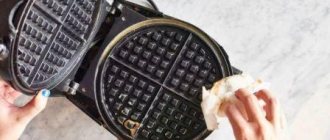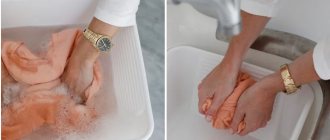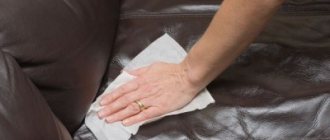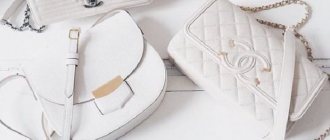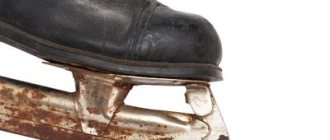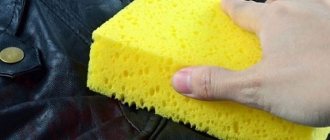Ammonia creates an alkaline environment on the surface of the fabric, which changes the structure of the dye molecules, which facilitates the process of removing traces of organic matter. The main thing is to choose the right second component of the mixture – detergent. The choice depends on the nature of the contamination.
Attention! Ammonia and ammonia are not the same thing. Ammonia is a 10% solution of ammonium hydroxide with a sharp unpleasant odor, in other words, ammonia diluted with water, which, despite the name, does not contain alcohol-containing substances (toxic if ingested). In turn, ammonia is ammonium chloride, an odorless white crystalline powder that is used as a fertilizer or food additive, but is completely useless for removing stains.
General tips:
- First, test the product on an inconspicuous area of clothing so as not to spoil the item;
- remove the stain, starting from the edges and moving towards the center;
- do not exceed the suggested concentrations of substances;
- on the bottle with ammonia alcohol it is written “ammonia 10%”;
- buy the product at the pharmacy;
- Ammonia is toxic, try not to inhale its fumes.
Ammonia 10% is ammonia
How to remove stains with ammonia: valuable tips for the home
*Review of the best according to the editors of simplerule. ru. About the selection criteria. This material is subjective in nature, does not constitute advertising and does not serve as a purchase guide. Before purchasing, consultation with a specialist is required.
Ammonia, when used correctly, can revive not only a person, but also his favorite things, and even interior items. It would seem like a simple solution of ammonia in water, but what an effect. Our editors have collected the safest and most effective ways to use ammonia to remove stains.
Removing stains from clothes
Fat marks
Method No. 1
. Fresh. Finely grate the laundry soap, add to it an equal amount of ammonia and 2 times more turpentine. Move carefully. Apply the finished composition to the greasy mark and leave for a few minutes. Afterwards, rinse with warm water.
Method number 2
. Obsolete. To remove stubborn stains from fabric, an effective combination of ammonia (10%), salt and water (ratio 1:1:3) is suitable. Apply the finished mixture liberally to the stain and let it dry. Then send the item to the wash.
Method number 3
. Grease stains on silk. Silk is a rather finicky material, so the product used should be more gentle. Prepare a mixture of glycerin, water and ammonia (1: 1: 0.5.) Soak the stained area in the resulting solution for 10-15 minutes. Rinse under running warm water.
Milk/ice cream
Method No. 1
. To remove fresh stains, you can use a weak soap solution with ammonia (ratio of soap, ammonia and water 1:1:6). It is enough to wash the fabric in this composition and then rinse thoroughly in clean water.
Method number 2
. To remove old contaminants, ammonia is used in combination with glycerin. Mix ammonia (10%), water and glycerin in equal quantities. Blot the dirty area of the material with the resulting mixture. Leave for 8-10 minutes. Then put it in the washing machine.
If the fabric is colored, there should be less ammonia: mix 2 tbsp. spoons of glycerin and water, add 5 drops of ammonia solution. Next, place the product between two pieces of clean cloth and iron it. Wash the item in a convenient mode.
Alcohol
Method No. 1
. Effective against beer. A fresh stain can be removed with a slightly warmed ammonia solution. Gently treat the dirty area with warm mixture. Wash the product with soap and warm water. The old stain is removed with an ammonia-glycerin mixture (ratio 1:1). Treat the beer trail with the resulting composition. Then wash the item in any convenient way.
With method No. 2
. Effective against white wine. Ammonia + turpentine + white soap. Mix the components in a ratio of 1:2:10. Using a cotton swab, apply the mixture. Leave for about 30 minutes. Afterwards, wash the treated area in warm soapy water, then in clean cold water.
Method number 3
. Effective against red wine. A fresh stain can be sprinkled with dry table salt. If it is already dry, then lightly soak the salt with water to make a paste. After 5 minutes, apply a paper napkin to absorb any remaining moisture. Immediately rinse in cold water with the addition of ammonia (proportion - 1 teaspoon of ammonia is needed for 1 water).
Grass
Grass marks are one of the most difficult to remove. But they can be completely removed if urgent measures are taken.
Method No. 1
. Ammonia + water + hydrogen peroxide. Component ratio 1:1:0.1. Moisten the grass mark generously with the prepared solution. Leave for 5 minutes. Rinse thoroughly in cold water.
Method number 2
. Soap solution + ammonia. Mix the components in a ratio of 1 teaspoon of ammonia to 1 tbsp. solution. Wash the stain in the resulting mixture. Rinse thoroughly.
Method number 3
. Hydrogen peroxide + ammonia. For white things. Take the components in equal quantities. Apply locally to the stain. Leave for 5-10 minutes. Send the item for washing.
Cosmetics
Foundation can be removed by moistening it with an ammonia solution and sprinkling it with baking soda. Leave to act for 5-10 minutes. Then rinse in warm water.
Lipstick and mascara can be easily removed with a clean ammonia solution (be sure to rinse with warm, clean water afterwards).
The trace of perfume is removed in the following way: apply ammonia, after 3-5 minutes - a solution of hydrosulfite (4 g of substance per 1 cup of water). After another couple of minutes, walk with a solution of oxalic acid (5 g of substance per 1 cup of water).
An ammonia aqueous solution can easily remove such stains. It is enough to apply the prepared composition (1 tbsp. water + 1/2 tsp. ammonia) to the stain and leave it to act. When the mark is washed away, wash the item in warm water with the addition of liquid soap.
Resin
Traces of asphalt resin and gasoline can be easily removed with a simple compound. To prepare it, you need to mix 1 teaspoon of potato starch with a few drops of ammonia and hydrogen peroxide. Apply the resulting thick mixture onto the stain in a dense layer and let it dry completely. Then carefully remove the material from the surface with a soft brush for clothes. Repeat the process if necessary. Then rinse thoroughly in cold water.
Tea, coffee, cocoa
Such stains are considered to be of medium complexity. They can be easily dealt with using one of the methods described below.
Method No. 1
. Ammonia + glycerin. Mix both components in a ratio of 1:4. Apply the composition using a cotton swab. Leave for a certain time until the mark disappears. Then rinse in cold water.
Method number 2
. Ammonia + soda. Add 1 teaspoon of ammonia solution and the same amount of soda ash to water (1 l). Rinse the stain thoroughly with the resulting liquid. Leave for 5-10 minutes if necessary. Then rinse first in warm, then in cold water, adding a little vinegar.
Method number 3
. Ammonia + water. Dilute ammonia in water (1:1 ratio). Using a cotton swab, blot the stain thoroughly with this mixture. Let it dry. Rinse off with running water.
Fruits, vegetables, berries
A mixture of ammonia and peroxide is suitable for removing currant stains. Mix them in equal proportions, apply and leave for a while. Then rinse under cold running water.
To remove stains from cherries, cherries, and lingonberries, use pure ammonia. Apply the composition directly to the dirty area and leave for 3-4 hours. Then wash in a convenient way.
Separately, it is worth mentioning the juice from red cabbage and beets. It is believed that such stains on white woolen items are a real disaster, since they cannot be washed off. Ammonia will solve the problem: it is enough to treat the contaminated area first with 5%, then with 2% ammonia solution. Then rinse thoroughly in cold water.
Faded traces
Ammonia will help here too. To remove faded stains from clothes, an aqueous ammonia solution is suitable: add a whole bottle of ammonia to hot water (fill a medium-sized basin). Soak the product in this water for 15-20 minutes. Then rinse thoroughly several times in clean water.
Sweat stains
Ammonia is a great way to remove sweat stains from white fabric. Dilute in 1 tbsp. water, 1 teaspoon each of table salt and ammonia solution. Dip the contaminated area into the resulting mixture and leave in it for 2-4 hours. Then rinse thoroughly.
Blood stains
Ammonia can only remove fresh traces of blood. But before using it, it is important to thoroughly rinse the dirty area under running cold water. Then mix 2 tbsp. spoons of ammonia with 1 tbsp. water. Soak the blood stain in the resulting solution for 1 hour. Then put it in the washing machine.
Mold stains
If an item is damp and has mold stains on it, do not rush to throw it in the trash. The product will help “reanimate” boiling in an ammonia-salt solution. You need to add 5 ml of ammonia and 2 tbsp to the water (per 1 liter). spoons of salt. Place on low heat and simmer for half an hour. Let cool slightly. Treat the contaminated area with the prepared mixture and leave for some time to react. Then wash in a convenient way and dry in a ventilated place or in the fresh air.
Carefully clean colored clothes
When the origin of the stains is unclear, the best homemade composition for restoring the purity of colored fabric is salt and ammonia dissolved in water. You can properly clean a soiled item as follows. First of all, we prepare the soiled clothes - take a dry brush and go over the surface of the fabric. Then we wet the brush in water and repeat the procedure. Turn the product inside out. We arm ourselves with a wooden plank, wrap a clean white cloth around it several times and place it under the cleaning area. You don’t have to be smart and use a blotter or paper napkins.
Now the preparatory procedures are completed, the product is ready for cleaning. We soak a clean soft cloth in the prepared cleaning composition (do not use colored fabrics so as not to accidentally stain the item being cleaned), a cotton swab or a soft brush. We process the edge of the contamination so that it does not blur, and move towards the central part. It is better to first use a solution of a weaker concentration and increase it as you clean. When the dirty mark leaves the surface of the material, soap the problem area, wash and rinse the entire product. If the fabric is well dyed, you can use a mixture of ammonia, acetone and denatured alcohol as a cleaning solution.
Treatment of various surfaces
Furniture
Ammonia is great for updating wooden furniture elements. This product is especially effective when treating old furniture made from durable wood species such as oak or walnut. It is enough to moisten a cotton cloth in a 12% ammonia solution and carefully walk over the surface of the product. It will take on a beautiful brown-gray hue.
Ceramic tile
Ammonia, or more precisely, an aqueous solution of ammonia, qualitatively cleans various contaminants from the tiled surface. In addition, it copes well with unpleasant odors.
Painted window frames and walls
An ammonia solution effectively cleans walls and window frames painted in a light color. Dilute 2 teaspoons of ammonia in 1 liter of water and thoroughly wipe the painted surface. If the contamination is too persistent, the dose of the active substance can be increased 5 times.
Wooden floors
Ammonia will help remove stubborn stains and add shine to wood flooring. For 8-10 liters of water for washing floors, 8-15 tablespoons of ammonia are enough. Use the resulting mixture to walk on floors that have been previously washed with water or detergent. The effect will be amazing!
Attention! This material is subjective in nature, does not constitute advertising and does not serve as a purchase guide. Before purchasing, consultation with a specialist is required.
Ammonia is not only the specific smell of ammonia, but also a valuable assistant in the process of washing and cleaning the most capricious linen. It should be added to hard water - 1-3 tsp. for a whole bucket of water - to soften it. Thick knitwear will become softer if you soak it in a solution of ammonia (1 tbsp per 1 liter of water) before washing. Washing clothes with ammonia is a gentle treatment of laundry.
Benefits of Vinegar
- You can safely wash a new item by adding a little vinegar to the water. Then it will remove the aggressive elements used in manufacturing.
- By washing with vinegar, you don't have to worry about hard water stains or laundry detergent stains. It will easily remove both.
- By adding the product to the washing machine, you will ensure not only gentle cleaning of things, but also the safety of the equipment itself.
- Vinegar is sometimes even used as a washing powder mixed with soda. It not only disinfects clothes, but also has a softening effect. Therefore, wearing things washed in it will be much more pleasant.
Removing stains
To remove contaminants, ammonia solution is used for household purposes, perhaps most often. And, of course, mainly in places where using conventional detergents is either inconvenient or ineffective.
What concentration should you prepare the solution for these manipulations? The more ammonia you add per 100 ml of water, the stronger and faster its properties will appear, but the aggressive effect on the tissue structure will also increase. The most common cleaning solution, which we recommend using, is 1 part ammonia and 5 parts water, although if necessary, you can increase or decrease the saturation of the mixture.
Stain remover
Heavily soiled laundry can be cleaned with stain remover or ammonia. Things should be soaked in water with ammonia, then washed as usual.
Ammonia (½ tsp) and glycerin (2 tsp) applied to tea, coffee or cocoa marks will remove them completely from the fabric.
Beer is afraid of warm ammonia. Apply ammonia to the stain and rinse.
The resin is removed with a mixture consisting of:
- 100 g of wine alcohol;
- 15 ml of any gasoline;
- 35 ml of ammonia.
Cosmetics are reduced with ammonia:
- mascara and lipstick - clean;
- cream, including foundation, 10%, followed by filling the stain with baking soda;
- perfume from light-colored materials - first with this product, then the contamination is treated with an aqueous solution of hydrosulfite (4 g per 1 tbsp. water) and after a couple of minutes - a solution of oxalic acid (5 g per 1 tbsp. water).
Contaminants whose etymology is unknown are erased with a composition obtained from equal parts of ammonia and wine alcohol and a solvent (sulfuric ether, acetone or gasoline).
After all manipulations, the laundry should be rinsed well and washed.
Getting rid of stains using ammonia
There are different recipes for eliminating traces of contaminants of various origins with ammonia. It is used in combination with other components and separately.
Here are some recipes:
Here are a few recipes for a cleaning mixture based on ammonia solution:
As you can see, it is not necessary to purchase expensive stain removers with questionable composition. It is enough to acquire several skills to be able to cope with various unforeseen unpleasant situations.
Advantages and disadvantages of the method
There are many advantages to using ammonia in glass cleaning solutions. The obvious advantages include:
- low cost;
- availability of purchase - the drug is available in any pharmacy;
- efficiency;
- ease of use;
- cost-effectiveness.
Minuses:
- strong unpleasant odor;
- need to be careful when using.
Despite the disadvantages, the use of ammonia solution is so effective that you should not abandon it due to shortcomings.
Whitening
In addition to removing stains, ammonia is used in everyday life to return things to their original boiling white color, and it also copes with this task with a bang. True, it does not work as well alone as with an assistant in the form of hydrogen peroxide, so stock up on both products. We will soak children's tights, your work blouse and even tulle, yellowed from the sun, in the same solution: add 50 ml of peroxide and 25 ml of ammonia to 4-5 liters of hot water (about 70 ˚C), and soak things in it for several hours and then rinse thoroughly. It is worth noting that this procedure does not replace washing and should be carried out on items that have already been cleaned of heavy soiling.
Advice
White clothes that have become the victim of a bright sock accidentally falling into the washing machine can also be saved with the help of such soaking, if, of course, the colored fabric has not faded too much.
How to eliminate the formation of rust on things?
You shouldn’t put off removing rusty deposits from things for too long. They can disrupt the structure of cotton, linen and other textiles. Typically, rust on clothing occurs from metal buckles, buttons, buttons, loops (during washing or drying). If you decide not to dry clean the item, you can try to remove the stain yourself using citric acid or freshly squeezed lemon juice. Let's consider several options for removing rust from things:
- Depending on the degree of contamination, you need to take from 5 g to 20 g of citric acid and dissolve it in 200 ml of hot water. The solution must be heated and the rust-stained area should be dipped into it for a short time, then rinse the area with warm water.
- Moisten the area where the rust has formed with the juice of freshly squeezed lemon, iron it with an iron through gauze, then rub the stain again with a pre-moistened cotton pad, and rinse the clothes with warm water.
If a rusty stain has formed on white leather or suede accessories (bag, gloves, etc.), then it makes sense to immediately take the item to dry cleaning. As practice shows, removing such stains at home rarely gives positive results.
Grooming
Ammonia (a little) is added during washing to soften the water.
When caring for white woolen items, it is necessary to add ammonia. If wool pellets appear, you need to add 3 tbsp to 10 liters of soap solution. l. ammonia along with 1 tbsp. l. turpentine. The wool is soaked in the solution for a day. Afterwards you need to rinse it in cool water. The method is also effective for getting rid of pills from knitwear.
The collar area of a woolen dress or jacket will be eliminated from grease marks by consistent treatment of the stain:
After this, the item is washed; when rinsing the laundry, ammonia should be added again.
Getting rid of traces of milk is possible with a mixture of 3 tbsp. l. ammonia with 3 tbsp. l. denatured alcohol and 1 tbsp. l. simple table salt applied to the stain. Let everything soak in, then wash the item with laundry detergent.
About vinegar and ammonia
Almost 95% of vinegar is water. But it also includes acetic and other acids, esters, carbohydrates, aldehydes, and trace elements. It is best known as an additive to dishes. But, in addition to food purposes, vinegar can bring many more benefits around the house.
In particular, it is added during washing to get rid of stains on clothes. It can easily cope with the same problem on flooring, upholstered furniture and walls.
Ammonia is a water-based solution of ammonium hydroxide. It has a sharp, characteristic odor. It’s not for nothing that in the old days young ladies were given to smell it when they fainted. It is actively used for medical purposes, as well as in everyday life. Using this product you can get rid of many contaminants.
Disinfection
For the same tiles, treating with ammonia is not just cleaning, but also the prevention of fungus and mold, which makes the grout between the tiles look simply terrible. Of course, it is better to use regular alcohol to disinfect your hands, but it is quite possible to treat objects with ammonia. For example, hair combs and brushes are soaked in an ammonia solution, which are difficult to properly rinse and disinfect in any other way.
How to get rid of sweat and deodorant stains from colored and dark fabrics
White deodorant stains from black clothes are removed in another way.
The product should be used to remove stains from linen, cotton, and black clothing. You need to mix salt (1 tsp) with water (200 ml) and ammonia (1 tsp). Apply to stains, wait 20 minutes, rinse.
Salt
The product is ideal for processing silk and black textures. Salt is mixed with water (200 ml 1 tsp). Before the procedure, the clothes are washed, then left in the solution with soap for another quarter of an hour, the next stage is washing with rinsing.
Laundry soap
Laundry soap is good for removing deodorant stains from woolen items and black clothing. Things are washed in laundry soap and hot water, left for a couple of hours, and rinsed thoroughly.
Ammonia alcohol
This is the most commonly used method for removing white stains from black clothes if they are fresh. For 1000 ml of water, add a teaspoon of ammonia and wash it by hand.
Ammonia is an excellent means of preserving the color of fabrics. Add:
Traces of dark (black, blue) ink are removed from colored materials by applying 60 ml of a liquid consisting of ammonia and ethyl alcohol diluted in distilled water in a ratio of 1:1:1. First, evaluate the resistance of paints to ammonia in an invisible place.
Getting rid of mold stains and traces of dampness is possible according to the following scheme:
Things to consider before removing stains
Origin of the stain.
The cleaner is selected for a specific type of stain. That's why professional stain removers have products for different stains: for example, Dr. Beckmann produces separate products for ballpoint pen and felt-tip pen stains, glue, blood and protein stains. If you choose the wrong cleaner, it will not dissolve the stain.
This is important to consider when choosing a washing method. For example, fat is easier to wash off with hot water, and blood is easier to wash off with cold water.
Type of fabric.
Need to consider:
- Composition of the material. The most difficult stains to remove are from delicate fabrics: satin, velvet, wool, silk, fine synthetics. They do not tolerate aggressive household chemicals and friction. Nylon or silk acetate may dissolve along with the stain after applying acetone or solvent. Natural fabrics are less picky about the composition of the cleaner due to their loose structure, but they absorb dirt more strongly, so they are difficult to wash the first time.
- Color. White clothes can be washed with almost any stain remover without worrying about discolouration. But to treat colored fabrics, you cannot use hydrogen peroxide, chlorine-containing products, solvents and citric acid.
General rules.
If you have a stain, read the recommendations before washing:
- Check the tag. On the label, manufacturers indicate recommendations for care - washing and drying.
- If you are not sure about the effect of the product, test it on a small piece of cloth. A sample attached to a tag will do.
- Immediately blot fresh stains with a dry cloth and cover with salt or starch so that the marks do not spread.
- If possible, wash your clothes as quickly as possible. But try not to rub the fabric too much so that there are no pellets left on it.
- It is better to take clothes made from delicate fabrics to the dry cleaner immediately. Experimenting with folk remedies and aggressive compounds can ruin the color or structure of the fabric.
Repellent
The use of ammonia in everyday life is not limited to the area of cleaning: it can also serve in the fight against insects that have decided to settle in your apartment. Brown ants, which are often simply impossible to remove using traditional methods, will forget the way to your kitchen if they smell ammonia. You can also take it with you on outings: it works no worse than factory repellents, and costs much less.
Advice
If you apply a tiny amount of ammonia to an insect bite, it will stop itching.
Beauty product Ammonia has interesting properties for dry and problematic skin of the feet. If you add literally a couple of drops of this product to the baths, the skin softens, cracks heal faster, the unpleasant odor recedes, and the roughening of the skin occurs more slowly.
Important!
Ammonia is used in small quantities orally to induce vomiting in case of poisoning, but it is better not to use it outside medical institutions for such purposes: a slight overdose and you will get a burn to the mucous membranes and serious poisoning.
Removing fat in the oven
All housewives know how difficult it can be to wipe grease off an oven. Ammonia will be a real salvation in this difficult matter.
It is necessary to leave the container with ammonia in it overnight, close the door tightly, and in the morning wipe everything thoroughly with a dry cloth. The dirt will easily come off the walls, and there will be no smell left either. The only inconvenience is fumes, so it is better to work with open windows and wearing rubber gloves.
How to clean a down jacket from greasy conditions: with ammonia, without washing, at home
How to clean a down jacket from grime at home A down jacket is a fashionable and very warm product that is very popular among young people today. But, like all other things, down jackets often get dirty - and even more so - greasy. How to clean a down jacket from grease at home and what products can be used?
Rules for washing down jackets
Before you start cleaning your down jacket from grease or normal dirt, you need to familiarize yourself with the main rules for this procedure:
If the jacket is filled with artificial down, then it is forbidden to purchase products containing acetic acid - they will damage the product; Nylon and nylon are sensitive to various solvents; If a solvent is used, the cleaning agent must be applied from the inside of the product to avoid streaks; Before you begin large-scale washing using chemicals, you need to test the substance on an inconspicuous area of clothing;
Before applying stain removers to stains, you should carefully read the instructions for them and strictly follow them; It is important to study the information on the outerwear label - it usually indicates what and at what temperature the product can be washed. Traditional cleaning methods These recipes are easy to prepare, do not require large financial expenditures, and most of the ingredients can be found at home.
Ammonia plus soap
Greasy places most often appear on those parts of the down jacket that touch our body. These are: along the zipper line, on the sleeves, near the pockets, on the collar. This situation can be solved without cleaning products. For example, taking ammonia and soap.
Take 1 tsp. ammonia; Mix with 1 tsp. liquid soap; Pour everything into a small container of water; Beat all ingredients until foamy;
Using a clean dishwashing sponge, apply to dirty parts of the down jacket; Rub in, wait 20 minutes, rinse with water. Good to know! This recipe allows you not only to clean grease on down jackets, but will also help to cope with any type of dirt on fabrics. A universal option!
An equally effective way to remove grease from a down jacket. Lemon can be easily purchased at any grocery store, and table salt can be found in any kitchen.
To get the product, you need to mix:
A tablespoon of salt; Juice from a large lemon; Add a little water or vinegar.
The resulting substance should be applied to the greasy area with a clean dishwashing sponge or rag. Leave for 10 minutes, wipe off, rinse with water. In addition to removing greasy areas, the fabric will become softer and fresher.
Ammonia and hydrogen peroxide
Probably the simplest option, but no less effective than the previous ones. You can also add salt, soda, starch, etc. to these substances.
Mix equal parts peroxide with ammonia; Rub into the greasy area on the down jacket; Rinse with clean water (if the stains do not disappear, repeat the procedure).
Important! These agents are quite aggressive. Therefore, before using them, it is worth checking how the fabric will react to such a composition. If you add vinegar to these substances, you can achieve a greater cleaning effect.
Other cleaning options In addition to the methods described above, you can resort to somewhat non-standard methods of cleaning a down jacket from greasy stains. For example, you can take glass cleaning liquid and wipe the stain with it.
If the dirt is not very noticeable, you can use aviation gasoline. Before use, the contaminated area should be steamed, then wiped with the substance, and apply salt or starch, then clean with a brush.
Hair shampoo is also considered by housewives to be a good way to combat greasy stains. You need to beat it until foam forms, and just rub the stained area.
How to properly clean a down jacket at home Let’s take a closer look at cleaning a down jacket from stains in the washing machine and in “manual mode”.
Hand washing This method is the most gentle for a down jacket. But it also has a minus - the time required for washing and proper drying. This method is suitable for cases when the down jacket is dirty only in some places, and there is no need to completely clean it.
The main advantage of the manual method is the ability to clean the product without the need to wet the down filling. Ideal for removing grease from individual parts of items.
How to clean:
Before washing, wash all stains with laundry soap; Hang the product on hangers to make it easier to clean; Lightly moisten the jacket tangentially with a spray or shower;
Apply detergent to the entire down jacket using a soft sponge; Rinse off the resulting foam with water; Place to dry on hangers in a warm place.
We use an automatic machine. Here the process stretches out a little:
Preparation. Remove all foreign objects from your pockets, unfasten everything that is possible, remove fur, if any; Inspection, “stretching”. Take a close look at the down jacket and determine its most contaminated places. Most often, sleeves, collars, and pockets become greasy. It is difficult to wash them the first time, therefore, it is necessary to wash them with a cleaning agent and lightly rub them; Turn the item inside out and fasten the zippers. This is necessary so that the thing does not lose its shape;
Place a few tennis balls in the washing machine drum. With their help, the fluff inside the product will not get lost. Balls can shed - wash them first and make sure this is so; It is better to choose a liquid detergent specially designed for washing down jackets. Gel or capsule powders are also suitable; It is important to choose the correct washing mode. The best option is the most gentle one, or for wool products. The water should not be heated more than 35 degrees. RPM – 500. Washing tips
Tip 1: cleaning depending on the type of stain:
Rust from a down jacket can be removed with lemon juice, which should be applied to the contaminated area for at least 24 hours, then rinsed with water. If the result is not satisfactory, the process can be repeated; A greasy stain on a jacket can be removed using purified aviation gasoline. First, the stain is wiped with a solution, and then an adsorbing fat agent is applied to it: soda, talc, salt, starch, etc.; Lipstick can be easily removed from a down jacket with cotton wool soaked in ethyl alcohol; Sweat and white stains from snow and salt can be washed off with equal parts of vodka and ammonia;
If mold is noticed on the jacket, then you need to quickly pour lemon juice over it, then sprinkle salt on the stain, and dry it in the sun. Then the down jacket will have to be washed; Foundation and makeup can be removed with regular detergent. It is simply rubbed into the stain and then washed off with water; If chewing gum is stuck to the down jacket, then you need to put a bag with an ice cube on it. Once the gum dries, it can be easily removed with a blunt, flat object; Grass and leaf stains are cleaned with ammonia and soapy water in a ratio of 1 to 4;
Coffee stains must first be sprinkled with salt, and then wiped with alcohol and vinegar (1 to 1); The blood is initially washed with cold water, then treated with soapy water and washed off; Ink can be removed using a cotton swab dipped in alcohol and valerian. Tip 2: how to dry a down jacket after washing
Washing is far from the end, because you also need to properly dry the cleaned product so that the filler does not get lost inside. Recommendations:
After washing in the machine, use the most gentle spin and dry mode. But it’s much easier to put tennis balls in the drum; Drying should continue for at least 1.5 hours; You should not immediately hang the down jacket in the closet, as the lining may still remain damp. The best option is on hangers and in the hallway; If the product is dried on a hanger, then it must be systematically fluffed so that the fluff does not clump.
Tip 4: dry cleaning your down jacket
Dry cleaning is an opportunity to save a lot of time and effort. Yes, you will have to pay for this, but you will be guaranteed that greasy stains (and any other stains) will be completely cleaned, and there will be no risk of damaging the product.
What are the advantages of this option:
Dry cleaners use modern washing technologies, and your item will look as if it had just been purchased in a store; These enterprises know exactly which product will be most effective in a particular case. Moreover, you will not be afraid that the fluff will become crumpled;
The jacket will be dried in a special drying department, where the color of the product will be completely preserved, and then additional air treatment will be carried out to make the item as soft and fluffy as possible.
Rules to follow when removing contaminants
Before removing any formations on your own, you should familiarize yourself with the following tissue care rules:
- Dirt from thin fabrics is cleaned from the inside out;
- if the use of a certain stain remover can provoke a change in the color of a colored item, then it should be tested in an inconspicuous place;
- Don’t put off stain removal until later. This situation allows microelements to penetrate deeper into the tissue structure, which over time complicates their removal;
- Removing stains should begin with finding out the nature of the contamination on things. This can be done by appearance, color, smell or other characteristics;
- if you were unable to find out the nature of the origin of the stain, then first you should try more gentle products or universal stain removers;
- It is important to pay attention to the manufacturer’s recommendations for fabric care, which are indicated on the product label. The label contains instructions on how to wash, dry and iron the item, whether the material is suitable for dry cleaning or whether it is contraindicated;
- After removing the stain, the product must be rinsed with water or washed with washing powder.
- If the item cannot be washed, then the remaining stain remover is washed off by applying a cotton swab moistened with clean water.
Treatment of fabric with various solvents is called “dry cleaning,” that is, stains are removed without first soaking the item. Solvents are harmful, volatile and flammable substances. In dry cleaners, the use and storage of such materials takes place in special workshops that comply with technical safety standards. When using such solvents at home, you need to remember that:
- the use of such substances may harm the skin. Therefore, it is necessary to work with them with gloves, and after use you need to lubricate your hands with cream;
- cleaning should be carried out away from open fire and heating devices;
- Removal of contamination should be carried out in a well-ventilated area, since inhalation of large amounts of vapors of harmful substances can cause headaches and nausea.
Fertilizer
It is difficult to believe that a substance with such a pungent odor, and even alcohol, can be beneficial for plants, but with some species this is indeed the case. True, it is added in small quantities so as not to harm the seedlings. Gardeners say that this way it grows stronger and stronger.
If we have missed some way of using ammonia in everyday life, it is only because there are really a lot of them: hurry to take advantage of the versatility of this product for the sake of cleanliness in your home and more.
Benefits of ammonia
Hydrogen peroxide is widely known for its ability to remove stains.
However, it should only be used on white items. It is not suitable for colored fabrics. But there is another, no less effective cleaner that does not spoil the structure of dyed clothes - ammonia.
It is also a real lifesaver on faded items. Ammonia, like vinegar, has a softening effect. Therefore, it is added to water to reduce hardness. One to three teaspoons is enough to make 10 liters of water much softer.
They clean the window sill and window frames with it. And wooden surfaces that have faded over time seem to take on new life. For this purpose, a 12% concentration is used.
However, if you decide to use it to clean anything, remember to be careful first. After all, it can cause burns, and if inhaled, there is a risk of poisoning. By taking all precautions, you can be convinced of its enormous power and usefulness around the house.
